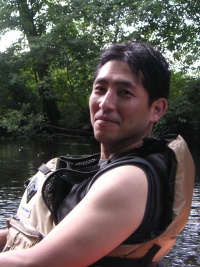CAZypedia celebrates the life of Senior Curator Emeritus Harry Gilbert, a true giant in the field, who passed away in September 2025.
CAZypedia needs your help!
We have many unassigned pages in need of Authors and Responsible Curators. See a page that's out-of-date and just needs a touch-up? - You are also welcome to become a CAZypedian. Here's how.
Scientists at all career stages, including students, are welcome to contribute.
Learn more about CAZypedia's misson here and in this article. Totally new to the CAZy classification? Read this first.
Difference between revisions of "User:Kiyohiko Igarashi"
Harry Brumer (talk | contribs) m (standardized picture format) |
|||
| (31 intermediate revisions by 2 users not shown) | |||
| Line 1: | Line 1: | ||
| − | [[Image:PICT7013.jpg| | + | [[Image:PICT7013.jpg|200px|right]]Kiyohiko Igarashi (Kiyo) is an Associate Professor of Forest Chemistry Laboratory, [http://www.fp.a.u-tokyo.ac.jp/graduate/english/index.html Department of Biomaterial Sciences], [http://www.a.u-tokyo.ac.jp/english/index.html Graduate School of Agricultural and Life Sciences] in the [http://www.u-tokyo.ac.jp/index_e.html University of Tokyo]. He received PhD degree in 1999 from Graduate School of Agricultural and Life Sciences in the University of Tokyo. Before receiving PhD, he focused on the kinetic analysis of cellobiose dehydrogenase <cite>Igarashi2002 Igarashi2005</cite>, extracellular flavocytochrome produced by filamentous fungi, with the late Professor Karl-Erik L. Eriksson (University of Georgia) and Professor Masahiro Samejima (University of Tokyo). After receiving the degree, he stayed in Uppsala University (Sweden) as a PostDoc from 2000 to 2001, and returned to the same lab in the University of Tokyo as an Assistant Professor. Currently he is doing kinetics of cellulase <cite>Igarashi2006 Igarashi2007</cite> and other CAZymes <cite>Igarashi2008 Ishida2009</cite> combined with 3D structure. He is also focusing on the single molecular observations of cellulase and chitinase acting at the solid/liquid interface <cite>Igarashi2009</cite>. |
| + | |||
| + | Kiyo loves staying in forest and mountainside, and lives very close to [http://en.wikipedia.org/wiki/Mount_Takao Mt. Takao], most famous mountain in Tokyo, and [http://en.wikipedia.org/wiki/Tama_Forest_Science_Garden Tama Forest Science Garden]. However, he spends totally 2.5 hrs by train to go to the lab and back to his residence everyday. He is a (self-professed) good Dad of three kids (one boy and two girls) playing tennis and radio-controlled car, and going fly- and lure-fishing with them. | ||
| − | + | == References == | |
| + | |||
| + | <biblio> | ||
| + | #Igarashi2002 pmid=11939907 | ||
| + | #Igarashi2005 pmid=15943818 | ||
| + | #Igarashi2006 pmid=16759230 | ||
| + | #Igarashi2007 pmid=17319934 | ||
| + | #Igarashi2008 pmid=18676702 | ||
| + | #Ishida2009 pmid=19193645 | ||
| + | #Igarashi2009 pmid=19858200 | ||
| + | </biblio> | ||
| + | |||
| + | [[Category:Contributors|Igarashi, Kiyohiko]] | ||
Latest revision as of 12:08, 8 February 2011
Kiyohiko Igarashi (Kiyo) is an Associate Professor of Forest Chemistry Laboratory, Department of Biomaterial Sciences, Graduate School of Agricultural and Life Sciences in the University of Tokyo. He received PhD degree in 1999 from Graduate School of Agricultural and Life Sciences in the University of Tokyo. Before receiving PhD, he focused on the kinetic analysis of cellobiose dehydrogenase [1, 2], extracellular flavocytochrome produced by filamentous fungi, with the late Professor Karl-Erik L. Eriksson (University of Georgia) and Professor Masahiro Samejima (University of Tokyo). After receiving the degree, he stayed in Uppsala University (Sweden) as a PostDoc from 2000 to 2001, and returned to the same lab in the University of Tokyo as an Assistant Professor. Currently he is doing kinetics of cellulase [3, 4] and other CAZymes [5, 6] combined with 3D structure. He is also focusing on the single molecular observations of cellulase and chitinase acting at the solid/liquid interface [7].
Kiyo loves staying in forest and mountainside, and lives very close to Mt. Takao, most famous mountain in Tokyo, and Tama Forest Science Garden. However, he spends totally 2.5 hrs by train to go to the lab and back to his residence everyday. He is a (self-professed) good Dad of three kids (one boy and two girls) playing tennis and radio-controlled car, and going fly- and lure-fishing with them.
References
- Igarashi K, Momohara I, Nishino T, and Samejima M. (2002). Kinetics of inter-domain electron transfer in flavocytochrome cellobiose dehydrogenase from the white-rot fungus Phanerochaete chrysosporium. Biochem J. 2002;365(Pt 2):521-6. DOI:10.1042/BJ20011809 |
- Igarashi K, Yoshida M, Matsumura H, Nakamura N, Ohno H, Samejima M, and Nishino T. (2005). Electron transfer chain reaction of the extracellular flavocytochrome cellobiose dehydrogenase from the basidiomycete Phanerochaete chrysosporium. FEBS J. 2005;272(11):2869-77. DOI:10.1111/j.1742-4658.2005.04707.x |
- Igarashi K, Wada M, Hori R, and Samejima M. (2006). Surface density of cellobiohydrolase on crystalline celluloses. A critical parameter to evaluate enzymatic kinetics at a solid-liquid interface. FEBS J. 2006;273(13):2869-78. DOI:10.1111/j.1742-4658.2006.05299.x |
- Igarashi K, Wada M, and Samejima M. (2007). Activation of crystalline cellulose to cellulose III(I) results in efficient hydrolysis by cellobiohydrolase. FEBS J. 2007;274(7):1785-92. DOI:10.1111/j.1742-4658.2007.05727.x |
- Igarashi K, Ishida T, Hori C, and Samejima M. (2008). Characterization of an endoglucanase belonging to a new subfamily of glycoside hydrolase family 45 of the basidiomycete Phanerochaete chrysosporium. Appl Environ Microbiol. 2008;74(18):5628-34. DOI:10.1128/AEM.00812-08 |
- Ishida T, Fushinobu S, Kawai R, Kitaoka M, Igarashi K, and Samejima M. (2009). Crystal structure of glycoside hydrolase family 55 {beta}-1,3-glucanase from the basidiomycete Phanerochaete chrysosporium. J Biol Chem. 2009;284(15):10100-9. DOI:10.1074/jbc.M808122200 |
- Igarashi K, Koivula A, Wada M, Kimura S, Penttilä M, and Samejima M. (2009). High speed atomic force microscopy visualizes processive movement of Trichoderma reesei cellobiohydrolase I on crystalline cellulose. J Biol Chem. 2009;284(52):36186-36190. DOI:10.1074/jbc.M109.034611 |
